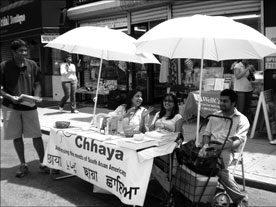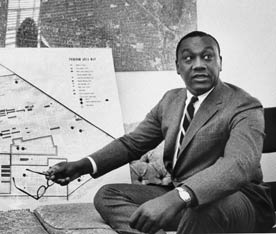Geographic Challenges
According to U.S. Census data, more than 250,000 South Asians live in New York City. While Queens is home to nearly two-thirds of this population, significant numbers reside in Brooklyn, the Bronx, and Manhattan. Within each borough, South Asian immigrants have settled in many different neighborhoods. In Queens alone, there are seven neighborhoods with more than 5,000 South Asian residents and 10 neighborhoods with between 1,000 and 5,000 community members.
Serving such a large geographic area, Chhaya has had to find new ways to reach its target population. Instead of solely relying on clients to come to the office, staff travel to different parts of the city to conduct community outreach. Religion plays an integral part in the lives of many members of the community, so Chhaya routinely distributes information outside of mosques in Jamaica and gurdwaras (sikh temples) in Richmond Hill.
Chhaya also produces a television program covering housing and community development issues that regularly appears on the ITV (International Television) network, which is watched in thousands of homes in the New York City area.
Chhaya’s services go beyond those typically offered by community development corporations. “The definition of CDC work is also broadening,” Agnani says. “It’s not necessarily [only] building [housing] any more. For us, the CDC movement is much broader than bricks and mortar.” Chhaya provides translation services in several different languages, including Bengali, Hindu, and Urdu, and offers English as a Second Language classes. It also represents clients in landlord-tenant disputes in housing court and does advocacy work on immigration and affordable housing.
Chhaya has expanded its role and influence by forging partnerships with other South Asian organizations, as well as with groups targeting various ethnic communities. It has developed youth programs and joined forces on common issues such as immigration reform with the Latin American Integration Center. It has also worked with traditional neighborhood-based community development corporations such as Forest Hills Community House to deliver workshops on first-time homeownership and predatory lending.
Some long-time observers of the community-development movement are concerned that EBCDCs divide neighborhoods by catering to a narrowly defined group and might create barriers to broader participation or involvement. Much of the criticism stems from fear that EBCDCs could exacerbate the tension surrounding the immigration debate.
More broadly, critics also see EBCDCs as discordant, or even incompatible, with the founding principles of the community-development movement. The implicit mission of community organizing and community development, which is rooted in the civil-rights-era fight against segregation, is to foster equality through housing integration, economic development, and civic participation. EBCDCs, in contrast, might be viewed as separating communities by narrowly defining them.
Changes in the CDC Paradigm
Earlier generations of community activists believe that CDCs must bring together neighbors who might have different backgrounds, incomes, social status, and cultures. Leaders of ethnic-based community development corporations have responded to these criticisms in the following ways:
- Ethnic-based organizations are open to all groups. The mission of EBCDCs is not to exclude other groups from their services. While their focus is on a specific group, their services are not limited to those community members alone. On the contrary, organizations welcome participation from all communities. This is especially true in areas with great diversity, such as New York City. “Our workshops are very diverse…people of all ethnicities attend our events. We get African-American, Latino, and white participants. We even had a Canadian immigrant at one of our recent events,” says Agnani.
- EBCDCs provide services to groups who are not always reached by traditional community development corporations. Some ethnic populations are unable to access services from existing organizations for a number of reasons, for example, language barriers, concern about immigration status, and cultural norms. Recent immigrants, who might be averse to civic participation for the same reasons, could be ignored or invisible to traditional CDCs. By providing culturally sensitive and multilingual translation services, EBCDCs attract people to the community-development movement who might not otherwise become involved.
- Ethnic groups are not monolithic. Immigrant populations are comprised of people from a variety of backgrounds. The South Asian community, for example, represents tremendous diversity in terms of religion, language, and culture. South Asia has a long history of national, religious, and ethnic conflict whether between India and Pakistan, Hindus and Muslims, or other groups. Uniting South Asians under the community-development umbrella is no small accomplishment. Drawing these factions together exemplifies and advances the inclusive spirit upon which community development was founded.
- EBCDCs are part of a larger community-development movement. Ethnic-based CDCs do not operate in isolation. Almost all of these organizations build coalitions with other EBCDCs and with traditional community development corporations. Along with a host of other organizations, Chhaya has joined Housing First!, an alliance of organizations, businesses, and individuals committed to working together to solve New York City’s affordable-housing crisis.
Ethnic-based CDCs do not represent a break with existing practice; they demonstrate an evolution of the community-development movement. Organizations like Chhaya CDC are simply responding to changing conditions. Agnani says, “I think we do the same things as CDCs that serve established communities…. [The needs] get a little bit more complex in immigrant communities because of immigrant status issues, cultural, and language issues, but fundamentally it’s not different. These are working people who are peacefully living in the city and need access to resources and stability.”






Comments